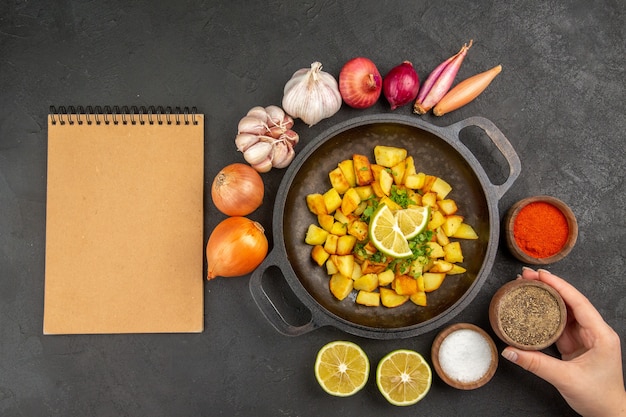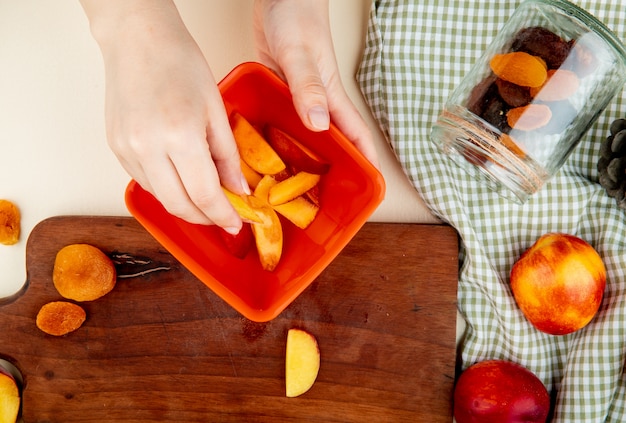If you're looking for a delicious and authentic taste of the Dominican Republic, look no further than mangu. This simple yet satisfying dish is a staple in Dominican cuisine, and for good reason. It's essentially mashed plantains, but trust me, it's so much more than that. The creamy texture, subtle sweetness, and versatility make mangu a culinary delight that can be enjoyed for breakfast, lunch, or dinner.
I've been fortunate enough to spend time in the Dominican Republic, immersing myself in the vibrant culture and, of course, the incredible food. Mangu is a dish you'll find everywhere, from bustling street food stalls to elegant restaurants, and each bite evokes a sense of warmth and familiarity. The best part? It's surprisingly easy to make at home, allowing you to recreate a piece of Dominican culinary magic in your own kitchen.
In this article, I'll guide you through the ins and outs of crafting the perfect mangu, sharing tips, tricks, and personal insights gained from my Dominican adventures. We'll cover everything from choosing the right plantains to mastering the art of mashing, along with exploring some of my favorite toppings and variations. So grab your ingredients and get ready to embark on a culinary journey to the Dominican Republic!
(Part 1) All About Plantains: The Foundation of Mangu

Before we dive into the recipe, let's get acquainted with the star ingredient: the plantain. You might think, "Isn't that just a banana?" Well, they're related, but they're not the same. Plantains are starchy and firm, even when ripe, while bananas are sweet and soft. They're like cousins, but with distinct personalities and roles in the culinary world.
Choosing the Right Plantains: The Key to Flavor
For a perfect mangu, you need to choose green plantains, also known as unripe plantains. Their firm texture and green-yellow color are essential for achieving the creamy consistency and subtle sweetness that defines mangu. Don't be tempted to use yellow or black plantains, as their sweetness and softness will alter the dish entirely.
Think of it this way: green plantains are like the foundation of a sturdy house; they provide the structure and base for a delicious mangu. Using ripe plantains would be like trying to build a house on sand; it wouldn't hold up and would likely end up a sticky mess.
Storing Your Plantains: A Patience Game
Once you have your green plantains, the next step is to store them properly. You want them to ripen just enough to achieve that perfect balance of firmness and slight give. Store them at room temperature for a few days, allowing them to naturally ripen. You'll know they're ready when they feel firm but slightly yielding to gentle pressure.
If you're in a hurry, you can speed up the ripening process by storing the plantains in a paper bag. The trapped ethylene gas will help them ripen faster. However, keep an eye on them to avoid over-ripening. You want to achieve that sweet spot of firmness and slight give, not a mushy mess.
(Part 2) Preparing Your Plantains: Simple Steps for Success

Now that you have your perfectly ripened green plantains, it's time to start preparing them. Don't worry, this part is incredibly simple, and you'll be surprised how quickly you can get started.
Peeling and Cutting: The First Step
Start by peeling the plantains. Use a sharp knife to cut off the ends, then carefully peel the skin off. I find it easiest to peel them in strips, but feel free to peel them in whatever way works best for you. Just remember to avoid tearing the flesh, as this can affect the final texture of your mangu.
Once the plantains are peeled, cut them into chunks. The size of the chunks doesn't matter too much, but smaller chunks will cook faster. Feel free to experiment with the size, but keep in mind that smaller chunks will create a smoother mangu.
(Part 3) Cooking the Plantains: The Heart of the Recipe

Now we get to the heart of the recipe: cooking the plantains. There are a few different methods, but boiling is my go-to choice. It's simple, reliable, and ensures that the plantains cook evenly, resulting in a perfect mangu.
Boiling Method: A Time-Honored Technique
Here's how to cook your plantains to perfection using the boiling method:
- Fill a large pot with water and bring it to a rolling boil. Make sure there's enough water to cover the plantains completely.
- Gently add the plantain chunks to the boiling water and cook for approximately 15-20 minutes, or until they are tender. Remember, overcooking will make them mushy, so keep an eye on them.
- You can test for doneness by piercing a plantain chunk with a fork. If it goes in easily, it's ready to be mashed. If it's still resistant, give it a few more minutes of cooking time.
Other Cooking Methods: Exploring Alternatives
If you prefer to explore other cooking methods, a pressure cooker or steaming are viable alternatives to boiling. However, boiling remains the simplest and most reliable method for achieving the desired texture and flavor. If you're a fan of experimenting, feel free to try these alternative methods, but remember that boiling is a tried-and-true technique that always delivers excellent results.
(Part 4) Mashing Your Plantains: Unleashing Creamy Perfection
Now for the fun part: mashing the plantains! This is where you truly transform your cooked plantains into the creamy and delicious mangu that we all know and love. A little bit of elbow grease and the right tools are all you need to create magic.
The Mashing Technique: Tools and Tips
You can use a variety of tools for mashing, including a potato masher, a fork, or even a wooden spoon. However, my personal favorite is the traditional Dominican "pilón," a heavy wooden mortar and pestle. It's a powerful tool that delivers a smooth and creamy texture unlike any other.
If you don't have a pilón, don't worry! Just use the tool you have and mash the plantains until they achieve a smooth and creamy consistency. You might need to add a little water or broth to help create the desired texture, especially if you're using a potato masher or fork.
Adding Flavour: Enhancing the Mangu
While mashing, it's time to add some flavor. Butter and salt are essential elements that enhance the richness and flavor of the mangu. The butter adds a creamy richness, while the salt brings out the subtle sweetness of the plantains. Feel free to adjust the amount of salt and butter to your preference.
If you're feeling adventurous, you can also add a dash of cinnamon or nutmeg for a subtle warmth and complexity of flavor. Just a pinch is all you need to add a unique twist to your mangu.
(Part 5) Serving Your Mangu: The Art of Toppings
Congratulations! You've successfully created your own perfect mangu. Now it's time to serve it up and enjoy all the deliciousness. But remember, mangu is rarely enjoyed on its own; it's meant to be paired with an array of toppings that complement its creamy texture and subtle sweetness.
Traditional Toppings: A Culinary Symphony
Dominican cuisine offers a variety of traditional toppings for mangu, each adding a unique dimension to the dish. Here are some popular choices:
- "Picadillo": A savory ground beef stew bursting with flavor from onions, tomatoes, and aromatic spices. It adds a hearty and satisfying element to the mangu.
- "Salami": A Dominican-style salami with a spicy kick, adding a layer of heat and savory depth to the creamy mangu.
- "Queso frito": Fried cheese, often served with a dollop of sour cream, provides a creamy and cheesy contrast to the starchy mangu.
- "Eggs": Fried or scrambled eggs are a classic topping, adding a protein boost and a comforting familiarity to the dish.
- "Avocado": Sliced avocado adds a creamy richness and healthy fats, complementing the mangu's texture and flavor.
- "Red Onions": Thinly sliced red onions bring a sharp and tangy bite, adding a refreshing contrast to the richness of the mangu and other toppings.
Variations: Expanding the Possibilities
While these traditional toppings are delicious, don't be afraid to get creative and experiment with your own combinations! Mangu is a versatile dish that welcomes a variety of flavors.
- Seafood: Smoked fish, shrimp, or even crab can add a delightful savory and umami dimension to the mangu.
- Chicken: Grilled or roasted chicken offers a hearty and protein-packed topping, complementing the creamy texture of the mangu.
- Veggies: Sautéed peppers, onions, and mushrooms add a vibrant and flavorful twist to the dish, providing a healthy and satisfying alternative to meat-based toppings.
- Salsa: Add some spice with your favorite hot sauce, bringing a fiery kick to the creamy mangu.
(Part 6) Tips for the Perfect Mangu: Mastering the Art
Through years of experimenting and learning from Dominican cooks, I've picked up a few tricks to ensure that your mangu is always perfect. These tips will elevate your mangu from good to extraordinary.
Tips for Cooking: Avoiding Common Mistakes
- Don't overcook the plantains: Overcooking will result in mushy plantains, ruining the texture of your mangu. Keep a close eye on them and remove them from the heat as soon as they become tender.
- Don't over-mash the plantains: While a smooth and creamy texture is desired, a little bit of texture is perfectly fine. Over-mashing can result in a gluey and unappealing mangu.
Tips for Serving: Elevating the Experience
- Serve mangu hot: It's best enjoyed fresh and warm, allowing the flavors to shine and the creamy texture to remain pleasing.
- Get creative with your toppings: Don't be afraid to experiment and try new combinations of toppings. The beauty of mangu lies in its versatility and ability to accommodate a variety of tastes.
(Part 7) Understanding Mangu’s Significance: A Cultural Icon
Mangu is much more than just a delicious dish; it's a symbol of Dominican culture, deeply woven into the fabric of Dominican life. It's often considered a comfort food, reminding people of home, family, and the simple joys of Dominican cuisine. It's a dish that brings people together, fostering a sense of community and shared experience.
Beyond its culinary significance, mangu is also a symbol of cultural identity, representing the island's rich history and culinary heritage. It's a reminder of the Dominican Republic's vibrant culture, passed down through generations and cherished by locals and visitors alike.
(Part 8) Mangu Around the World: A Culinary Journey
While mangu originated in the Dominican Republic, its deliciousness has traveled far and wide. It's now enjoyed in many Caribbean countries, as well as in the United States and Europe. Its popularity continues to grow as people discover its unique flavor and versatility.
You can find dedicated mangu restaurants in cities around the globe, showcasing the dish's growing popularity and cultural impact. It's a testament to the power of food to connect people across cultures and continents, sharing a taste of the Dominican Republic with the world.
(Part 9) The Cultural Impact of Mangu: A Global Symbol
Mangu has transcended its status as a simple dish, becoming a symbol of Dominican culture on a global stage. It's often featured in movies, TV shows, and books, showcasing the island's rich culinary heritage and vibrant culture. It's even been used as a promotional tool for the Dominican Republic, highlighting the country's beauty, hospitality, and delicious food.
Whether it's appearing in a scene of a popular movie or being featured in a travel article, mangu is a powerful reminder of the Dominican Republic's warmth, hospitality, and rich food culture. It's a dish that continues to inspire and delight people around the world, connecting them to the heart of Dominican culture.
(Part 10) FAQs: Answers to Common Questions
What is the difference between a plantain and a banana?
Plantains and bananas are related but have distinct characteristics. Plantains are starchy and firm, even when ripe, while bananas are sweet and soft. Plantains are typically used in savory dishes, while bananas are used in sweet desserts.
Can I use ripe plantains for mangu?
No, you need to use green, unripe plantains for mangu. Ripe plantains are too sweet and soft, altering the texture and flavor of the dish.
How long should I boil the plantains?
Boil the plantains for approximately 15-20 minutes, or until they are tender. You can test them for doneness by piercing them with a fork. If it goes in easily, they're ready to be mashed.
What is the best way to mash the plantains?
A traditional Dominican pilón is the best tool for achieving a smooth and creamy texture. However, you can also use a potato masher, a fork, or even a wooden spoon. Experiment and find what works best for you.
What are some good toppings for mangu?
Popular toppings include picadillo, salami, queso frito, eggs, avocado, and red onions. But don't be afraid to get creative and explore your own topping combinations!
(Part 11) Conclusion: A culinary adventure Awaits
There you have it! You're now equipped with the knowledge and skills to create the perfect Dominican mangu. It's a simple dish but one that's packed with flavor, history, and cultural significance. Whether you're a seasoned chef or just starting out, I encourage you to give it a try. You might just discover your new favorite comfort food and a piece of Dominican culinary magic right in your own kitchen. ??Buen provecho! (Enjoy your meal!)
Everyone is watching

Corn on the Cob: The Ultimate Guide to Perfectly Cooked Ears
Healthy MealsAh, corn on the cob. Just the name evokes images of sunny days, barbecues, and that sweet, juicy flavour that ...

Perfect Pork Roast Oven Cooking Time: A Guide to Delicious Results
Healthy MealsThere's something truly satisfying about a perfectly roasted pork. The aroma alone is enough to make your mout...

Ham Cooking Time: How Long to Bake, Smoke, or Boil a Delicious Ham
Healthy MealsAh, ham. It's a classic, isn't it? A real crowd-pleaser, especially around holidays. And when done right, it'...

Scallops: The Ultimate Guide to Perfect Cooking
Healthy MealsAh, scallops. Those delicate, sweet, and utterly delicious morsels of the sea. They hold a special place in my...

Spaghetti Squash: The Ultimate Guide to Cooking and Serving
Healthy MealsRemember that time you saw spaghetti squash at the supermarket, looking all bumpy and strange, and thought, "W...
